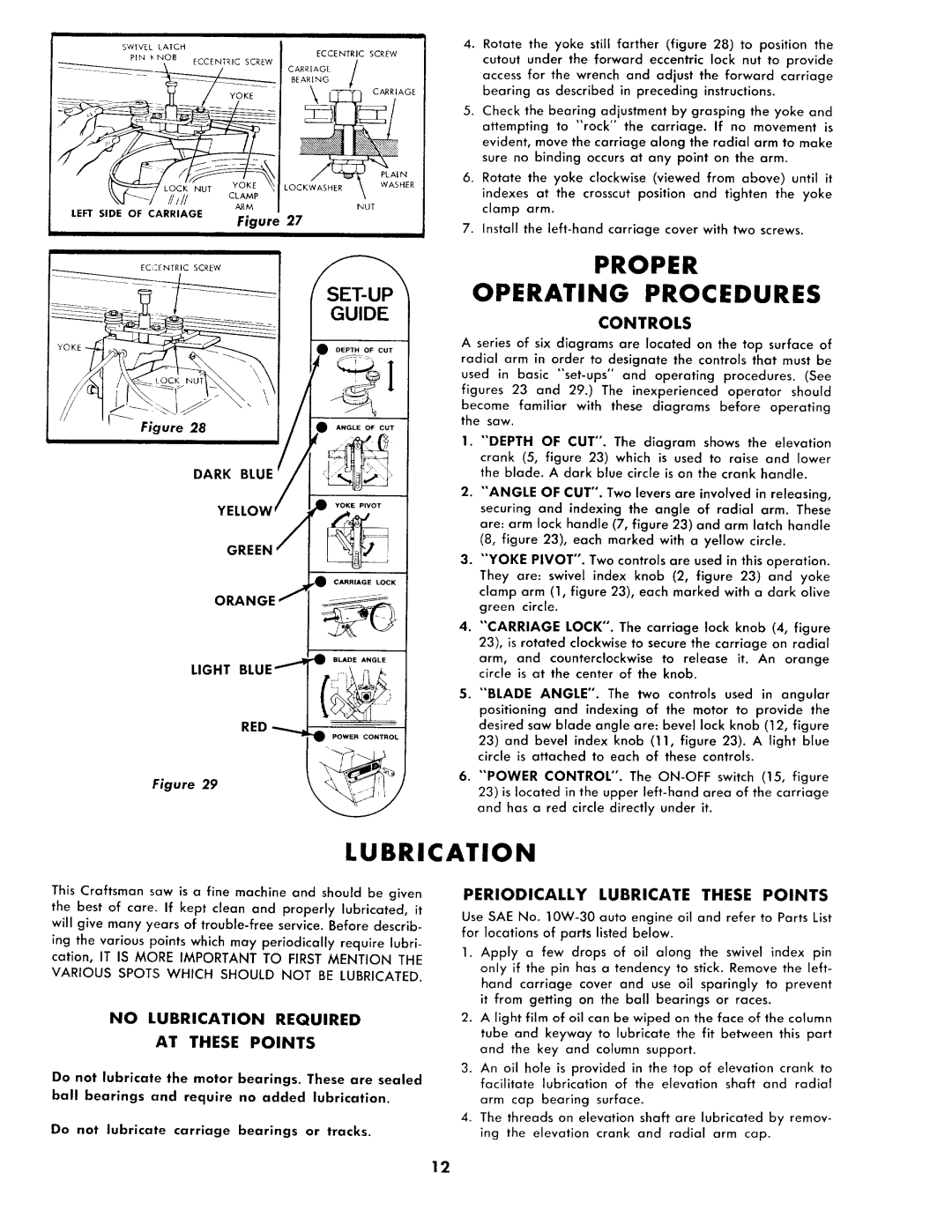
i
SWIVEL LATCH
ECCENTRIC SCREW
PEN _ NOB ECCENTRIC SCREW
4. Rotate the yoke still farther (figure 28) to position the |
cutout under the forward eccentric lock nut to provide |
_[-'-_-/ _'t// aAM_
CARRIAGE /
BEARING !/AGE
LOCKWASHER\ WASHER
| access for the wrench and adjust the forward carriage | |
| bearing as described in preceding instructions. | |
5. | Check the bearing adjustment by grasping | the yoke and |
| attempting to "rock" the carriage. If no movement is | |
| evident, move the carriage along the radial arm to make | |
| sure no binding occurs at any point on the arm. | |
6. | Rotate the yoke clockwise (viewed from | above) until it |
| indexes at the crosscut position and tighten the yoke | |
A/1MNUT
LEFT SIDE OF CARRIAGE | Figure 27 |
EC_ZENTRIC | SCREW |
SET-UP
GUIDE
DEPTH OF CUT
Figure 28 | ANGLE OF CUT |
DARK
YE
GREEN
CARRIAGE LOCK
ORANGE
LIGHT
RED
POWER CONTROL
Figure 29
clamp arm. |
7. Install the |
PROPER
OPERATING PROCEDURES
CONTROLS
A series of six diagrams are located on the top surface of radial arm in order to designate the controls that must be
used in basic
figures 23 and 29.) The inexperienced operator should
become familia_ with these diagrams before operating the saw.
1."'DEPTH OF CUT". The diagram shows the elevation crank (5, figure 23) which is used to raise and lower the blade. A clark blue circle is on the crank handle.
2."'ANGLE OF CUT". Two levers are involved in releasing, securing and indexing the angle of radial arm. These are: arm lock handle (7, figure 23) and arm latch handle (_8, figure 23), each marked with a yellow circle.
3."'YOKE PIVOT". Two controls are used in this operation. They are: swivel index knob (2, figure 23) and yoke clamp arm (1, figure 23), each marked with a dark olive green circle.
4."'CARRIAGE LOCK". The carriage lock knob (4, figure 23), is rotated clockwise to secure the carriage on radial
arm, and counterclockwise to release it. An orange circle is at the center of the knob.
5."'BLADE ANGLE". The two controls used in angular
positioning and indexing of the motor to provide the desired saw blade angle are: bevel lock knob (12, figure
23)and bevel index knob (11, figure 23). A light blue circle is attached to each of these controls.
6."POWER CONTROL". The
23)is located in the upper
LUBRICATION
This Craftsman saw is a fine machine and should be given
the best of care. If kept clean and properly lubricated, it will give many years of
ing the various points which may periodically require lubri- cation, IT IS MORE IMPORTANT TO FIRST MENTION THE VARIOUS SPOTS WHICH SHOULD NOT BE LUBRICATED.
NO LUBRICATION REQUIRED
AT THESE POINTS
Do not lubricate the motor bearings. These are sealed
ball bearings and require no added lubrication.
Do nat lubricate carriage bearings or tracks.
PERIODICALLY LUBRICATE THESE POINTS
Use SAE No.
1.Apply a few drops of oil along the swivel index pin only if the pin has a tendency to stick. Remove the left- hand carriage cover and use oil sparingly to prevent it from getting on the ball bearings or races.
2.A light film of oil can be wiped on the face of the column tube and keyway to lubricate the fit between this part and the key and column support.
3.An oil hole is provided in the top of elevation crank to
facilitate lubrication of the elevation shaft and radial arm cap bearing surface.
4.The threads on elevation shaft are lubricated by remov- ing the elevation crank and radial arm cap.
12
